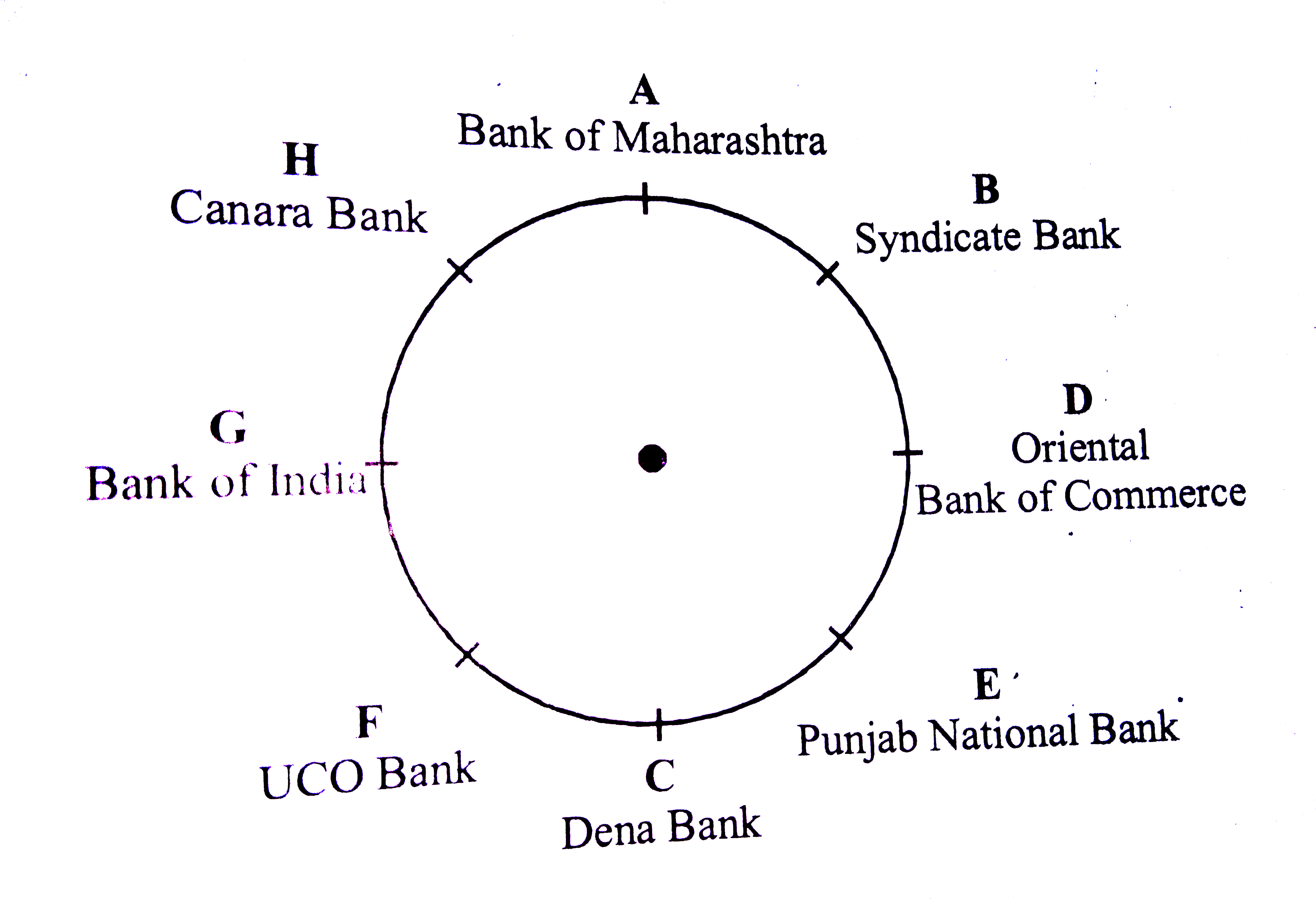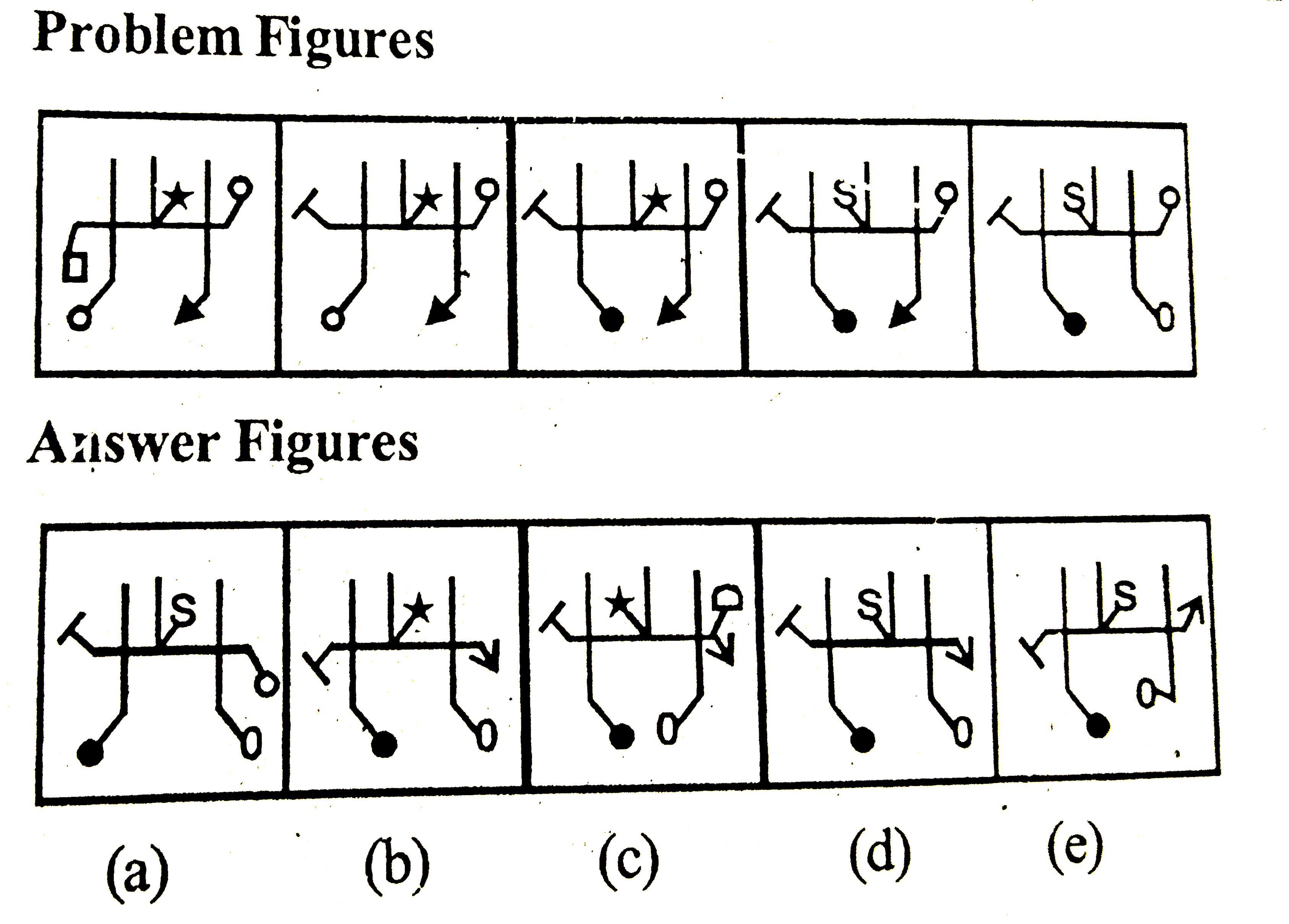Representatives from eight different Banks viz.. A, B, C, D, E, F, G and H are sitting around a circular table facing the centre but not necessarily in the same order. Each one of them is from a different Banks viz. UCO Bank, Oriental Bank of Commerce, Bank of Maharashtra, Canara Bank, Syndicate Bank, Punjab National Bank, Bank of India and Dena Bank. F sits second to right of the representative from Canara Bank. Representative from Bank of India is an immediate neighbor of the representative from Canara Bank. Two people sit between the representative of Bank of India and B. Cand E are immediate neighbours of each other. Neither C nor E is an immediate neighbor of either B or the representative from Canara Bank. Representative from Bank of Maharashtra sits second to right of D. Dis neither the representative of Canara Bank nor Bank of India. G and the representative from UCO Bank are immediate neighbours of each other. B is not the representative of UCO Bank. Only one person sits between C and the representative from Oriental Bank of Commerce. H sits third to left of the representative from Dena Bank. Representative from Punjab National Bank sits second to left of the representative from Syndicate Bank.
Which of the following is true with respect to the given seating arrangement ? Which of the following is true with respect to the given seating arrangement ?
B is the representative from Bank of Maharashtra
C sits second to right of H
The representative from Dena Bank sits to the immediate left of the representative from UCO Bank
The representative from Bank of Maharashtra and Syndicate Bank are immediate neighbours of each other
The correct Answer is:D
According to the question

The representative B from Bank of Maharashtra (A) and Syndicate Bank (B) are immediate neighbours of each other
Topper's Solved these Questions
Similar Questions
Correct figure in the following
 01:47View Solution
01:47View SolutionWhat should next in the following letter series based on English alphabet ?
CEA IKG OQM ?03:41View Solutionचुम्बकीय क्षेत्र (B ) में वेग (v ) से गतिमान आवेश q के एक कण पर लगने वाला बल (F ) है-
03:01View Solutionभू-चुम्बकत्व के विभिन्न अवयव क्या है ? इनकी परिभाषा दीजिए |
04:15View Solutionदिल्ली स्टेशन से, यदि हम 2 टिकट स्टेशन A के तथा 3 टिकट स्टेशन B के खरीदते हैं तो इनका कुल मूल्य १ 77 है परन्तु यदि हम 3 टिकट स्टेशन A के तथा 5 टिकट स्टेशन B के खरीदते हैं, तो इनका कुल मूल्य र124 है। दिल्ली से स्टेशन A तथा स्टेशन B तक टिकट के मूल्य ज्ञात कीजिए।
02:05View Solutionएक राजमार्ग पर दो बिन्दु A और B एक दूसरे से 90 किमी की दूरी पर है। एक कार A से तथा दूसरी कार B से एक साथ चलती हैं। यदि वे एक दिशा में चलती हैं, तो वे 9 घण्टे बाद मिलती हैं और वे विपरीत दिशा में चलती हैं, तो 97 घण्टे बाद मिलती है। उनकी चाल ज्ञात कीजिए।
02:13View Solutionएक व्यक्ति ₹ 1000 का नोट लेकर बैंक जाता है। वह कैशियर से बदले में केवल ₹5 और ₹10 के नोट देने के लिये कहता है। यदि उसे कुल ।75 नोट मिलते हैं, तो उसने ₹5 और ₹10 के कितने-कितने नोट प्राप्त किए?
04:44View Solutionताशों की गड्डी से तीन ताश यदृच्छया खींचे जाते हैं उनमें से एक बादशाह, एक बेगम और एक गुलाम हो, इसकी प्रायिकता ज्ञात करो।
06:17View Solutionपांच तत्व A, B, C, D व E के E∘ क्रमशः −1.36,+0.32,+1.36,−0.42 तथा −2.2.6 है उनको बढ़ती सक्रियता के क्रम में लिखो ।
03:15View Solutionसमान चालकता सेल में लिए गए दो विलयनों A तथा B के प्रतिरोध क्रमशः 50 ओम तथा 100 ओम है । यदि A व B के सामान आयतन मिला दिए जाये तो सामान चालकता सेल में मिश्रण का प्रतिरोध क्या होगा ?
(मोल A व B को मिलाने पर वियोजन की मात्रा में कोई परिवर्तन नहीं होता है)03:27View Solutionनीचे कुछ अभिक्रियाएँ दी गयी है-
(a) ACl2+B→BCl2+A
(b) B+DCl→ कोई अभिक्रिया नहीं
(c) C+2DCl→2D+CCl2
(d) C+ECl2→ कोई अभिक्रिया नहीं
(e) H2+ECl2→2HCl+E
(f) H2+FCl2→ कोई अभिक्रिया नहीं
उपरोक्त दिए तत्वों (A से F) को रासायनिक सक्रियता के घटते क्रम में व्यवस्थित करो ।View Solution∫ex{f(x)+f'(x)}dx को खंडश: समाकलन के प्रयोग से ज्ञात कर सकते है |
∫f(x)dx+∫exf'(x)dx=∫exf(x)dx+exf(x)−∫exf(x)dx+c
=exf(x)+c
तथा ∫eax{f(x)+f'(x)a}dx eaxf(x)a+c
इसलिए सही उत्तर चुने :
∫ex(tan−1x+11+x2)dx=03:18View Solution∫ex{f(x)+f'(x)}dx को खंडश: समाकलन के प्रयोग से ज्ञात कर सकते है |
∫f(x)dx+∫exf'(x)dx=∫exf(x)dx+exf(x)−∫exf(x)dx+c
=exf(x)+c
तथा ∫eax{f(x)+f'(x)a}dx eaxf(x)a+c
इसलिए सही उत्तर चुने :
e^(x)((1+sin x)/(1+cos x))dx=03:17View Solutionपहले बहुपद से दूसरे बहुपद को भाग करके, जॉंच कीजिए कि क्या प्रथम बहुपद द्वितीय बहुपद का एक गुणनखण्ड है :
g(t)=t2−3,f(t)=2t4+3t3−2t2−9t−1205:11View Solutionपहले बहुपद से दूसरे बहुपद को भाग करके, जॉंच कीजिए कि क्या प्रथम बहुपद द्वितीय बहुपद का एक गुणनखण्ड है :
g(x)=x3−3x+1,f(x)=x5−4x3+x2+3x+102:34View Solutionपहले बहुपद से दूसरे बहुपद को भाग करके, जॉंच कीजिए कि क्या प्रथम बहुपद द्वितीय बहुपद का एक गुणनखण्ड है :
g(x)=2x2−x+3,f(x)=6x5−x4+4x3−5x2−x−1502:49View Solution

